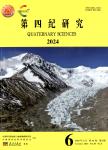A TAXONOMICAL AND ECOLOGICAL OVERVIEW OF RECENT AND HOLOCENE OSTRACODES OF THE NAM CO REGION, SOUTHERN TIBET
A TAXONOMICAL AND ECOLOGICAL OVERVIEW OF RECENT AND HOLOCENE OSTRACODES OF THE NAM CO REGION,SOUTHERN TIBET作者机构:Institut far Umweltgeologie Technische Universit~it Braunschweig PockelsstraBe 3 38106 Braunschweig Germany Institut fur Geowissenschaften Friedrich-Schiller-Universitat Burgweg 11 07749 Jena Germany Institute of Tibetan Plateau Research Chinese Academy of Sciences BeijingChina
出 版 物:《第四纪研究》 (Quaternary Sciences)
年 卷 期:2009年第29卷第4期
页 面:665-677页
核心收录:
学科分类:070903[理学-古生物学与地层学(含:古人类学)] 0709[理学-地质学] 07[理学]
基 金:the Deutsche Forschungsgemeinschaft grant Schw 671/8-1
摘 要:We present a list of living and (sub) fossil Ostracoda (Crustacea) from Holocene sediments from Lake NamCo,Southern Tibet, including descriptions, distribution and ecological data of the important taxa from the Nam Cocatchment. Species associations from lake surface sediments, sediment cores and outcrop samples consist of eight speciesincluding Candona candida ( O.F. Müller, 1776 ) , Candona xizangensis ( Huang, 1982 ) , Eucypris afghanistanensis( Hartmann, 1964) , Fabaeformiscandona danielopoli ( Yin & Martens, 1997 ) , Ilyocypris cf. mongolica ( Martens, 1991 ) ,? Leucocythere dorsotuberosa ( Huang, 1982 ) , Leucocytherella sinensis ( Huang, 1982 ) and Limnocythere inopinata ( Baird,1843). The dominant species are ? L. dorsotuberosa and L. sinensis. They show morphological variations with different degreesof ornamentation. We regard the variable noding and rib formation as intraspecific variability possibly driven byenvironmental factors. In general,the number and degree of ribs increases with water depth in ? L. dorsotuberosa. Thus,theornamentation may present a means to reconstruct(paleo) water depths. Our list is intended to serve as a taxonomical andpaleoecological primer for future paleolimnological work.



